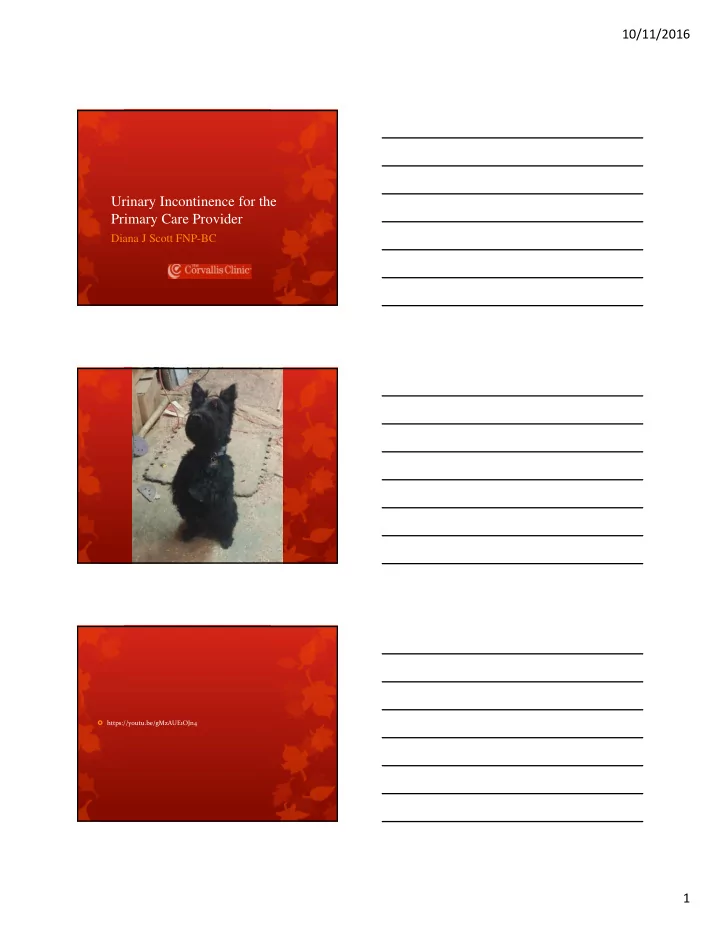

10/11/2016 Urinary Incontinence for the Primary Care Provider Diana J Scott FNP-BC https://youtu.be/gMzAUE1OJn4 1
10/11/2016 Assessment of Urinary Incontinence Urge Stress Mixed Other – overflow, postural, continuous, insensible, coital Assessment History Contributing comorbidities Assessment Points Storage symptoms Urgency, frequency, nocturia with or without incontinence Voiding symptoms Retention, hesitancy, straining to void Slow and/or interrupted stream, splitting or spraying, terminal dribble, position dependent micturition, incomplete emptying 2
10/11/2016 Assessment Points, cont’d Suspicious symptoms Hematuria, dysuria Consider a Volume Chart/Bladder Diary Three days, record the time they get up and time to bed, fluid intake, volume of urine passed each time voiding, every episode of incontinence and use of incontinence pads Bladder Diary Date/ Liquid Intake Urine Leaks Pad Time Volume Change 3
10/11/2016 Physical Exam A pelvic exam is not optional Atrophic vaginitis Skin breakdown Urethral caruncle or prolapse Pelvic organ prolapse Prostate exam for men Consider cathing for PVR Urinalysis Start with dipstick Blood ‐ send for UA for RBC count Leukocytes ‐ culture Nitrites ‐ culture Stress Incontinence Defect in urethral support Predisposing factors include obesity, constipation, parity Commonly associated with pelvic organ prolapse Leakage with cough or valsalva on pelvic exam, urethral hypermobility 4
10/11/2016 Treatment for SUI Pelvic floor physiotherapy Often needs formal referral, not just self Kegels Topical estrogen Referral to specialty for Bulking agents, urethral support surgery (sling) Pessary Overactive Bladder/Urge Incontinence OAB may present with or without incontinence Urgency Frequency ‐ >8 times in 24 hours Nocturia OAB/Urge Incontinence Treatment Lifestyle modification Behavioral therapy Pharmacologic options 5
10/11/2016 Realistic Expectations Discuss with your patient what their realistic goal is. OAB can generally be improved, but not cured Medications Two choices, antimuscarinic or beta3 agonist Data does not show a statistically significant difference in effectiveness between these medications Studies have shown fewer side effects with oxybutynin XL, tolterodine LA, oxytrol, trospium, solifenacin, and darifenacin. OAB/Urge Incontinence Medications All but Myrbetriq contraindicated in uncontrolled narrow angle glaucoma Myrbetriq contraindicated in uncontrolled hypertension 6
10/11/2016 OAB/Urge Incontinence Medications Oxybutynin (Ditropan, Oxytrol, Gelniq) Tolterodine (Detrol) Trospium (Sanctura) Fesoterodine (Toviaz) Solifenacin (Vesicare) Darifenacin (Enablex) Mirabegron (Myrbetriq) Other Types Mixed Overflow – BPH, neurogenic bladder Referral Concerning symptoms – hematuria, bladder pain Uncertainty of diagnosis Treatment failure Everyone with MS and with spinal cord injury with any bladder symptoms at all 7
10/11/2016 References • International Continence Society Fact Sheets, Assessment of Lower Urinary Tract Symptoms, Publications & Communications Committee 2015 Aug, pp 4- 6, can be read online at: www.ics.org/Documents/Documents.aspx?DocumentID=3102 • Pelvic floor muscle training versus no treatment for urinary incontinence in women. A Cochrane systematic review. Dumoulin C, Hay-Smith J, Eur J Phys Rehabil Med. 2008 Mar;44(1):47-63. • Kirchin V, Page T, Keegan PE, et al. Urethral injection therapy for urinary incontinence in women. Cochrane Database Syst Rev 2012;2:CD003881. Review. • Andersson KE, Chapple CR, Cardozo L, et al. Pharmacological treatment of urinary incontinence. In: Abrams P, Cardozo L, Khoury S, Wein A, editors. Incontinence. 4 th International Consultation on Incontinence ed. Paris: Health Publication Ltd.; 2009. PP. 631-700. • Bosch JL, Weiss JP. The prevalence and causes of nocturia. J. Urol. 2010; 184(2); 440-6. • Marinkovic SP, Rovner ES, Moldwin RM, et al. The management of overactive bladder syndrome. BMJ 2012;344:e2365. Review. • Epstein BJ, Gums JG, Molina E. Newer agents for the management of overactive bladder. Am Fam Physician. 2006 Dec 15: 74(12): 2061-2068. 8
Recommend
More recommend